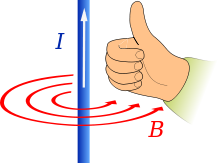According to this rule, we concluded that when current flows through a conducting wire, and an external magnetic field is applied across that flow, the conducting wire experiences a force perpendicular both to that field and to the direction of the current flow.
A left hand can be held as to represent three mutually orthogonal axes on the thumb, forefinger and middle finger. Each finger is then assigned to a quantity (mechanical force, magnetic field and electric field)
 According to Maxwell’s corkscrew rule, when current is flowing in a conductor a magnetic field creates around the conductor and their flux rotation direction according to tightening direction of the screw.
According to Maxwell’s corkscrew rule, when current is flowing in a conductor a magnetic field creates around the conductor and their flux rotation direction according to tightening direction of the screw.

If the conventional current is flowing away from the viewer, the magnetic field runs clockwise around the conductor, in the same direction that a corkscrew would have to turn in order to move away from the viewer.
The distinction between the right-hand and left-hand rule:-
Fleming’s left-hand rule is applicable to motors while the right-hand rule is applicable to generators.
In motors, the current carrying conductor is placed between the magnetic fields while in the generators, an external force is applied to rotate the armature conductor to generate electricity in between of magnetic field that’s why we use Fleming’s left-hand rule for motors and right-hand rules for generators.
